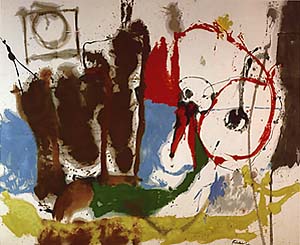 Mother Goose Melody, 1959, Virginia Museum of Fine Arts, Richmond, VA. Gift of Sydney and Frances Lewis, Photo by Dennis McWaters, ©1998 Virginia Museum of Fine Arts. Artwork ©1998 Helen Frankenthaler |
After
Mountains and Sea Frankenthaler 1956-1959 Solomon R. Guggenheim Museum January 16 to May 3, 1998 Guggenheim Museum Bilbao June 6 to October 4, 1998 |
|
After Mountains and Sea: Frankenthaler 1956-1959 focuses on the groundbreaking paintings created by Helen Frankenthaler in the early years of her career. Fifteen of the artist's key works from this period will be on view in the exhibition. Monumental in scale, the paintings address issues of formalism and evoke dreamlike images of landscape. After Mountains and Sea: Frankenthaler 1956-1959 is organized by Julia Brown, Curator of Special Exhibitions at the Solomon R. Guggenheim Museum. "Helen Frankenthaler is an artist who advanced the development of abstract painting at a pivotal moment in its history," said Thomas Krens, Director of the Solomon R. Guggenheim Foundation. "The Guggenheim is particularly pleased to present a selection of major paintings from this significant body of work." Frankenthaler emerged as an artist at the height of the Abstract Expressionist period and began making works of great beauty, substance, and energy. The artist's innovative use of materials and her marriage of surface and medium opened up the field of possibilities for painting, influencing her contemporaries and subsequent generations of artists. Both Kenneth Noland and Morris Louis have cited their introduction to Frankenthaler's work as a catalyst to the formation of their mature styles. Born in 1928, Frankenthaler was raised in New York City, the daughter of a New York State Supreme Court Judge. She was educated at the Dalton School, where she first studied painting with Mexican artist Rufino Tamayo, and at Bennington College, where she continued painting under the tutelage of Paul Feeley. There she made an intensive study of Cubism, ultimately rejecting its limiting approach to composition. Early influences on the developing artist included masters such as Georges Braque, Arshile Gorky, Vasily Kandinsky, Joan Miro, and Pablo Picasso. Just a year after her graduation from Bennington College, Frankenthaler's painting Beach (1950) was chosen by Adolph Gottlieb for inclusion in the group show Fifteen Unknowns: Selected by the Artists of the Kootz Gallery. Soon after her return to New York City, Frankenthaler became associated with the circle of artists known as the second-generation New York School, which included, among others, Robert Goodnough, Grace Hartigan, Alfred Leslie, Joan Mitchell, and Larry Rivers. Heirs to the success of the first-generation New York School, these artists eventually formed camps around De Kooning and Pollock, the two most prominent members of the New York School. The gesturalism associated with De Kooning and Franz Kline became the leading style for the second-generation artists, but Frankenthaler was ultimately more influenced by Pollock. Pollock's rejection of the conventional brush and easel had a profound effect on Frankenthaler. She began to experiment with a similar approach to the canvas, laying it on the floor and working from above. In October of 1952, Frankenthaler created the now legendary Mountains and Sea, which is on view in the exhibition. Frankenthaler used thinned-down paint and poured it directly onto unprimed canvas to be absorbed into the fibers. In this first use of her "staining" technique she created a breathing landscape of shifting planes of color washes. This painting synthesized the influences that had informed Frankenthaler's work to that point and announced her arrival as a mature artist. As in the succeeding works from 1956-59 included in this exhibition, Mountains and Sea features no build-up of paint on the surface of the painting and little of the aggressive gesture that came to define much avant-garde painting of the 1950s. Mountains and Sea was interpreted as a radical work by Frankenthaler's contemporaries, and after a short period of making more densely composed paintings, the artist returned to the discoveries she had made in this piece. During the years 1956 to 1959, Frankenthaler further secured her artistic identity and increased her mastery as a painter. Paintings made during this period include Eden (1956) and Before the Caves (1958), both in the exhibition. These works express a tension between background and foreground, without any sense of traditional illusionism. The images are flat and lyrical, with airiness achieved through the generous use of bare canvas. They display Frankenthaler's original sense of color, along with the dynamic and animated style that became her signature. An illustrated catalogue published by the Guggenheim Museum and distributed by Harry N. Abrams, Inc. will accompany the exhibition. It contains a historical essay by Susan Cross, Curatorial Assistant at the Solomon R. Guggenheim Museum, and an in-depth interview with Helen Frankenthaler by Julia Brown. |